Report: Global Business Management and Organisation Behaviour Analysis
VerifiedAdded on 2022/11/13
|7
|1892
|54
Report
AI Summary
This report delves into the realm of global business management, examining the impact of globalization on international markets. It explores the phase model of globalization, which includes exporting, cooperative contracts (franchising and licensing), strategic alliances (joint ventures and wholly-owned affiliates), and wholly-owned affiliates. The report analyzes the strengths and weaknesses of each stage, providing insights into their implications for business performance. It discusses the benefits of exporting, such as reduced market dependency, while also highlighting potential drawbacks like increased production costs. Cooperative contracts, including franchising and licensing, are examined for their ability to facilitate market entry, along with their limitations in terms of control and cultural issues. Strategic alliances, such as joint ventures, are assessed for their cost and risk-sharing advantages, as well as their potential for cultural clashes and power struggles. Finally, wholly-owned affiliates are evaluated for their profit potential and control, while also acknowledging the high financial risks involved. The report concludes by emphasizing the importance of understanding the phase model for achieving a competitive advantage in the global market.
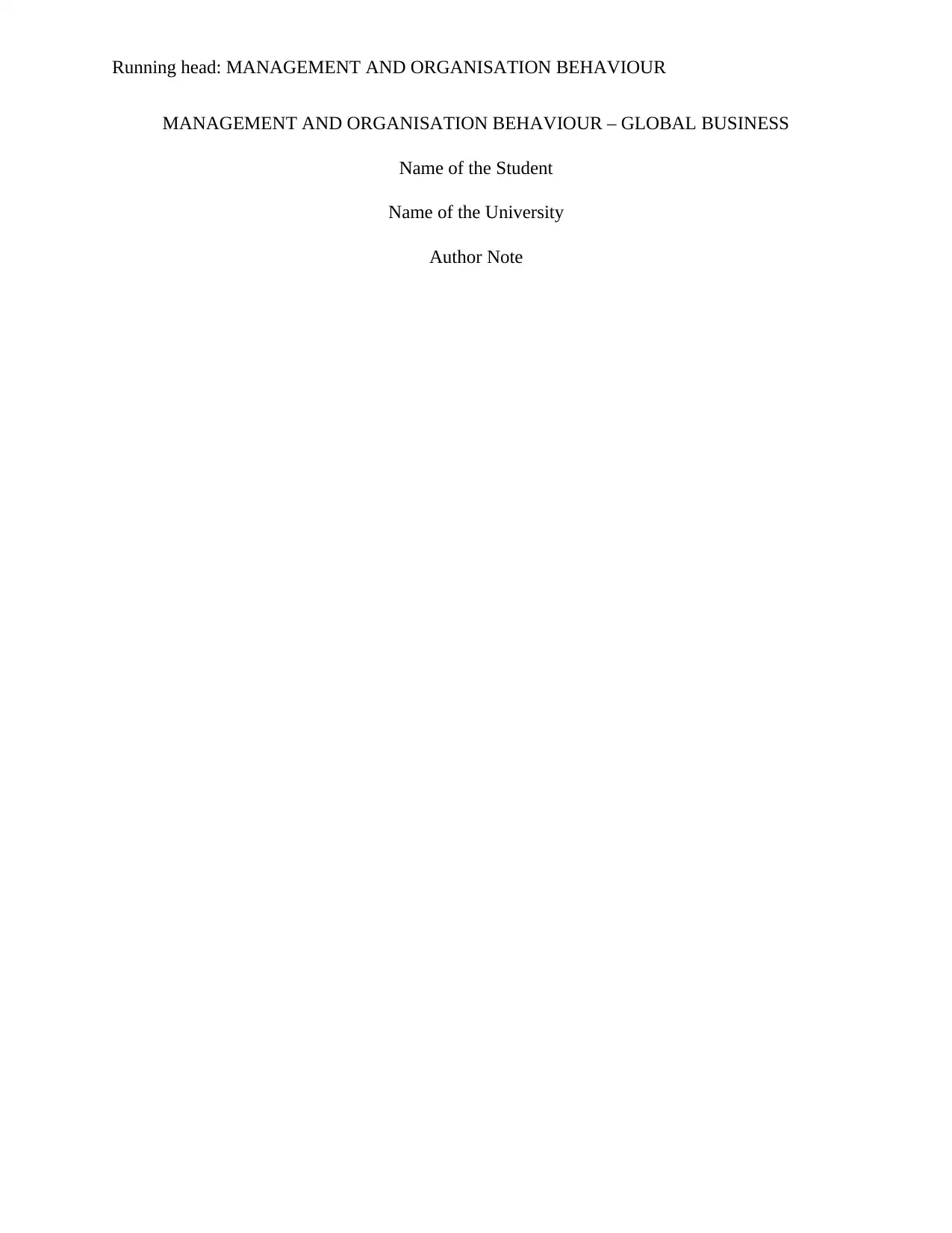
Running head: MANAGEMENT AND ORGANISATION BEHAVIOUR
MANAGEMENT AND ORGANISATION BEHAVIOUR – GLOBAL BUSINESS
Name of the Student
Name of the University
Author Note
MANAGEMENT AND ORGANISATION BEHAVIOUR – GLOBAL BUSINESS
Name of the Student
Name of the University
Author Note
Paraphrase This Document
Need a fresh take? Get an instant paraphrase of this document with our AI Paraphraser
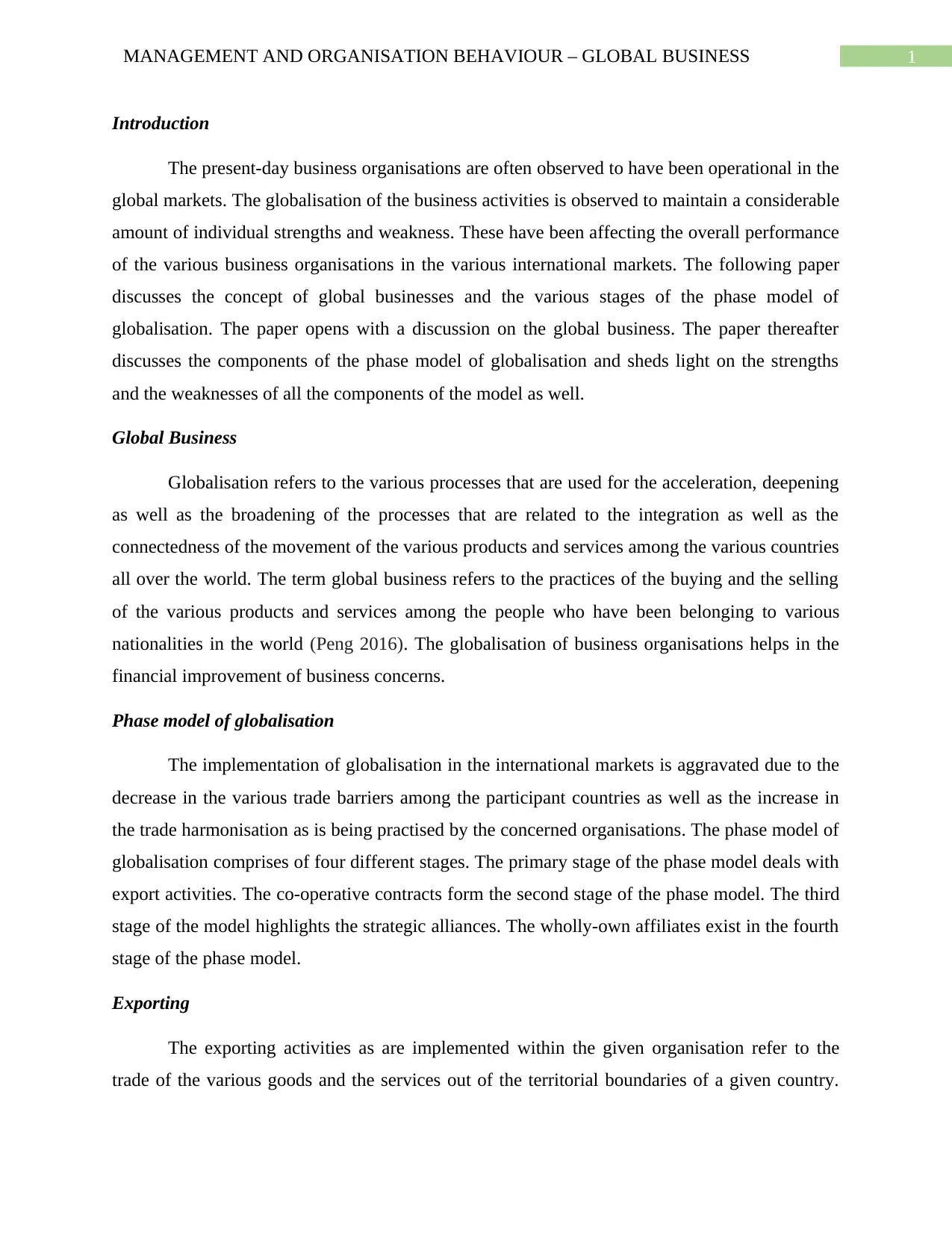
1MANAGEMENT AND ORGANISATION BEHAVIOUR – GLOBAL BUSINESS
Introduction
The present-day business organisations are often observed to have been operational in the
global markets. The globalisation of the business activities is observed to maintain a considerable
amount of individual strengths and weakness. These have been affecting the overall performance
of the various business organisations in the various international markets. The following paper
discusses the concept of global businesses and the various stages of the phase model of
globalisation. The paper opens with a discussion on the global business. The paper thereafter
discusses the components of the phase model of globalisation and sheds light on the strengths
and the weaknesses of all the components of the model as well.
Global Business
Globalisation refers to the various processes that are used for the acceleration, deepening
as well as the broadening of the processes that are related to the integration as well as the
connectedness of the movement of the various products and services among the various countries
all over the world. The term global business refers to the practices of the buying and the selling
of the various products and services among the people who have been belonging to various
nationalities in the world (Peng 2016). The globalisation of business organisations helps in the
financial improvement of business concerns.
Phase model of globalisation
The implementation of globalisation in the international markets is aggravated due to the
decrease in the various trade barriers among the participant countries as well as the increase in
the trade harmonisation as is being practised by the concerned organisations. The phase model of
globalisation comprises of four different stages. The primary stage of the phase model deals with
export activities. The co-operative contracts form the second stage of the phase model. The third
stage of the model highlights the strategic alliances. The wholly-own affiliates exist in the fourth
stage of the phase model.
Exporting
The exporting activities as are implemented within the given organisation refer to the
trade of the various goods and the services out of the territorial boundaries of a given country.
Introduction
The present-day business organisations are often observed to have been operational in the
global markets. The globalisation of the business activities is observed to maintain a considerable
amount of individual strengths and weakness. These have been affecting the overall performance
of the various business organisations in the various international markets. The following paper
discusses the concept of global businesses and the various stages of the phase model of
globalisation. The paper opens with a discussion on the global business. The paper thereafter
discusses the components of the phase model of globalisation and sheds light on the strengths
and the weaknesses of all the components of the model as well.
Global Business
Globalisation refers to the various processes that are used for the acceleration, deepening
as well as the broadening of the processes that are related to the integration as well as the
connectedness of the movement of the various products and services among the various countries
all over the world. The term global business refers to the practices of the buying and the selling
of the various products and services among the people who have been belonging to various
nationalities in the world (Peng 2016). The globalisation of business organisations helps in the
financial improvement of business concerns.
Phase model of globalisation
The implementation of globalisation in the international markets is aggravated due to the
decrease in the various trade barriers among the participant countries as well as the increase in
the trade harmonisation as is being practised by the concerned organisations. The phase model of
globalisation comprises of four different stages. The primary stage of the phase model deals with
export activities. The co-operative contracts form the second stage of the phase model. The third
stage of the model highlights the strategic alliances. The wholly-own affiliates exist in the fourth
stage of the phase model.
Exporting
The exporting activities as are implemented within the given organisation refer to the
trade of the various goods and the services out of the territorial boundaries of a given country.
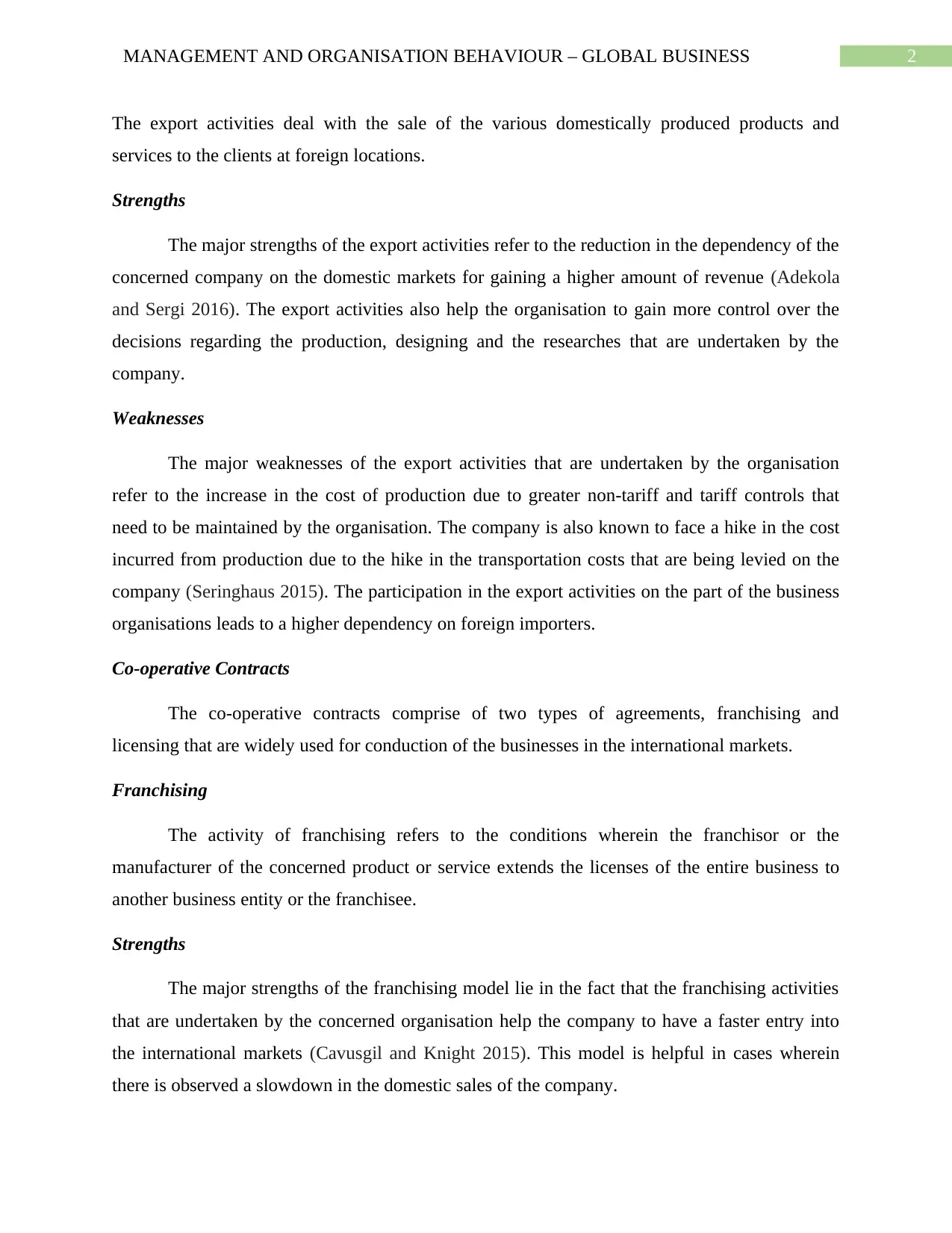
2MANAGEMENT AND ORGANISATION BEHAVIOUR – GLOBAL BUSINESS
The export activities deal with the sale of the various domestically produced products and
services to the clients at foreign locations.
Strengths
The major strengths of the export activities refer to the reduction in the dependency of the
concerned company on the domestic markets for gaining a higher amount of revenue (Adekola
and Sergi 2016). The export activities also help the organisation to gain more control over the
decisions regarding the production, designing and the researches that are undertaken by the
company.
Weaknesses
The major weaknesses of the export activities that are undertaken by the organisation
refer to the increase in the cost of production due to greater non-tariff and tariff controls that
need to be maintained by the organisation. The company is also known to face a hike in the cost
incurred from production due to the hike in the transportation costs that are being levied on the
company (Seringhaus 2015). The participation in the export activities on the part of the business
organisations leads to a higher dependency on foreign importers.
Co-operative Contracts
The co-operative contracts comprise of two types of agreements, franchising and
licensing that are widely used for conduction of the businesses in the international markets.
Franchising
The activity of franchising refers to the conditions wherein the franchisor or the
manufacturer of the concerned product or service extends the licenses of the entire business to
another business entity or the franchisee.
Strengths
The major strengths of the franchising model lie in the fact that the franchising activities
that are undertaken by the concerned organisation help the company to have a faster entry into
the international markets (Cavusgil and Knight 2015). This model is helpful in cases wherein
there is observed a slowdown in the domestic sales of the company.
The export activities deal with the sale of the various domestically produced products and
services to the clients at foreign locations.
Strengths
The major strengths of the export activities refer to the reduction in the dependency of the
concerned company on the domestic markets for gaining a higher amount of revenue (Adekola
and Sergi 2016). The export activities also help the organisation to gain more control over the
decisions regarding the production, designing and the researches that are undertaken by the
company.
Weaknesses
The major weaknesses of the export activities that are undertaken by the organisation
refer to the increase in the cost of production due to greater non-tariff and tariff controls that
need to be maintained by the organisation. The company is also known to face a hike in the cost
incurred from production due to the hike in the transportation costs that are being levied on the
company (Seringhaus 2015). The participation in the export activities on the part of the business
organisations leads to a higher dependency on foreign importers.
Co-operative Contracts
The co-operative contracts comprise of two types of agreements, franchising and
licensing that are widely used for conduction of the businesses in the international markets.
Franchising
The activity of franchising refers to the conditions wherein the franchisor or the
manufacturer of the concerned product or service extends the licenses of the entire business to
another business entity or the franchisee.
Strengths
The major strengths of the franchising model lie in the fact that the franchising activities
that are undertaken by the concerned organisation help the company to have a faster entry into
the international markets (Cavusgil and Knight 2015). This model is helpful in cases wherein
there is observed a slowdown in the domestic sales of the company.
⊘ This is a preview!⊘
Do you want full access?
Subscribe today to unlock all pages.

Trusted by 1+ million students worldwide
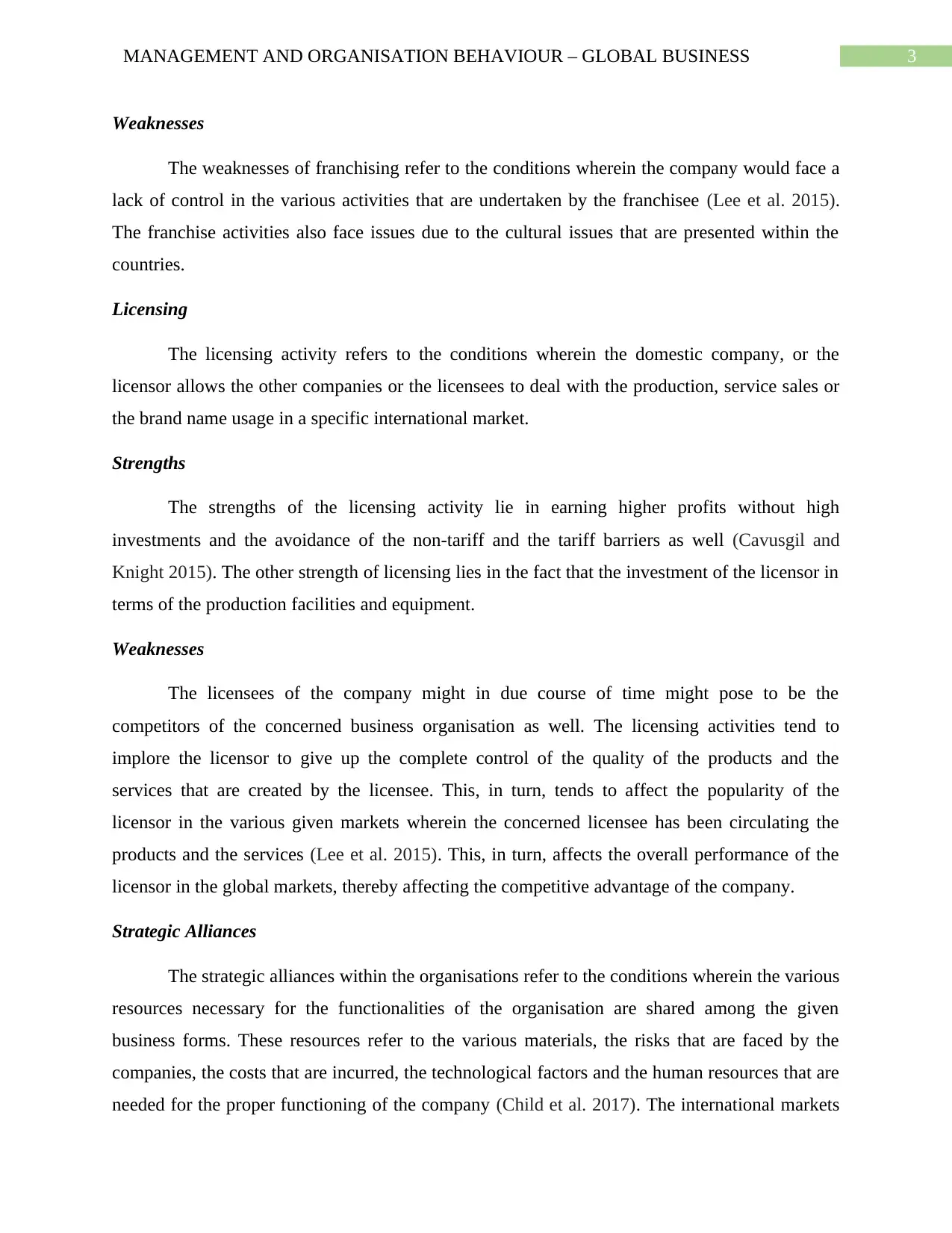
3MANAGEMENT AND ORGANISATION BEHAVIOUR – GLOBAL BUSINESS
Weaknesses
The weaknesses of franchising refer to the conditions wherein the company would face a
lack of control in the various activities that are undertaken by the franchisee (Lee et al. 2015).
The franchise activities also face issues due to the cultural issues that are presented within the
countries.
Licensing
The licensing activity refers to the conditions wherein the domestic company, or the
licensor allows the other companies or the licensees to deal with the production, service sales or
the brand name usage in a specific international market.
Strengths
The strengths of the licensing activity lie in earning higher profits without high
investments and the avoidance of the non-tariff and the tariff barriers as well (Cavusgil and
Knight 2015). The other strength of licensing lies in the fact that the investment of the licensor in
terms of the production facilities and equipment.
Weaknesses
The licensees of the company might in due course of time might pose to be the
competitors of the concerned business organisation as well. The licensing activities tend to
implore the licensor to give up the complete control of the quality of the products and the
services that are created by the licensee. This, in turn, tends to affect the popularity of the
licensor in the various given markets wherein the concerned licensee has been circulating the
products and the services (Lee et al. 2015). This, in turn, affects the overall performance of the
licensor in the global markets, thereby affecting the competitive advantage of the company.
Strategic Alliances
The strategic alliances within the organisations refer to the conditions wherein the various
resources necessary for the functionalities of the organisation are shared among the given
business forms. These resources refer to the various materials, the risks that are faced by the
companies, the costs that are incurred, the technological factors and the human resources that are
needed for the proper functioning of the company (Child et al. 2017). The international markets
Weaknesses
The weaknesses of franchising refer to the conditions wherein the company would face a
lack of control in the various activities that are undertaken by the franchisee (Lee et al. 2015).
The franchise activities also face issues due to the cultural issues that are presented within the
countries.
Licensing
The licensing activity refers to the conditions wherein the domestic company, or the
licensor allows the other companies or the licensees to deal with the production, service sales or
the brand name usage in a specific international market.
Strengths
The strengths of the licensing activity lie in earning higher profits without high
investments and the avoidance of the non-tariff and the tariff barriers as well (Cavusgil and
Knight 2015). The other strength of licensing lies in the fact that the investment of the licensor in
terms of the production facilities and equipment.
Weaknesses
The licensees of the company might in due course of time might pose to be the
competitors of the concerned business organisation as well. The licensing activities tend to
implore the licensor to give up the complete control of the quality of the products and the
services that are created by the licensee. This, in turn, tends to affect the popularity of the
licensor in the various given markets wherein the concerned licensee has been circulating the
products and the services (Lee et al. 2015). This, in turn, affects the overall performance of the
licensor in the global markets, thereby affecting the competitive advantage of the company.
Strategic Alliances
The strategic alliances within the organisations refer to the conditions wherein the various
resources necessary for the functionalities of the organisation are shared among the given
business forms. These resources refer to the various materials, the risks that are faced by the
companies, the costs that are incurred, the technological factors and the human resources that are
needed for the proper functioning of the company (Child et al. 2017). The international markets
Paraphrase This Document
Need a fresh take? Get an instant paraphrase of this document with our AI Paraphraser

4MANAGEMENT AND ORGANISATION BEHAVIOUR – GLOBAL BUSINESS
are witness to two major types of strategic alliances, the joint ventures and the wholly-owned
affiliates.
Joint Ventures
The joint ventures refer to the strategic alliances maintained within the two existent
business organisations that collaborate with each other in order to form a new and independent
company.
Strengths
The major strengths of this kind of strategic alliance lie in the avoidance of the non-tariff
and the tariff barriers that are faced by the concerned company while seeking entry into the
international markets. In case of the joint ventures, the companies involved bear the parts of the
costs and the risks that are faced by the company in the given international markets (Serrat
2017). The joint venture alliances are often observed to be helpful for the local small-scale
partners that bear a collaboration with the foreign company that had been attempting an entry
into the given international markets.
Weaknesses
The significant weaknesses in case of the joint ventures refer to the conditions wherein
the profits are shared among the partners in collaboration. The joint venture concerns tend to
represent a cultural merger thereby leading to the lack of leadership within the company as well
(Lim 2017). The joint ventures might also face issues due to the internal struggles for the power
and equality in ownership within the organisation.
Wholly-owned Affiliates
The wholly-owned affiliates refer to the companies that are located in the international
market locations but are entirely owned by the parent company.
Strengths
The major and the most significant advantage of the wholly-owned affiliates refer to the
fact that the parent company receives all the profits that are earned as well as enjoys complete
control over the functionalities of the wholly-owned affiliates (Yoboue et al. 2017).
are witness to two major types of strategic alliances, the joint ventures and the wholly-owned
affiliates.
Joint Ventures
The joint ventures refer to the strategic alliances maintained within the two existent
business organisations that collaborate with each other in order to form a new and independent
company.
Strengths
The major strengths of this kind of strategic alliance lie in the avoidance of the non-tariff
and the tariff barriers that are faced by the concerned company while seeking entry into the
international markets. In case of the joint ventures, the companies involved bear the parts of the
costs and the risks that are faced by the company in the given international markets (Serrat
2017). The joint venture alliances are often observed to be helpful for the local small-scale
partners that bear a collaboration with the foreign company that had been attempting an entry
into the given international markets.
Weaknesses
The significant weaknesses in case of the joint ventures refer to the conditions wherein
the profits are shared among the partners in collaboration. The joint venture concerns tend to
represent a cultural merger thereby leading to the lack of leadership within the company as well
(Lim 2017). The joint ventures might also face issues due to the internal struggles for the power
and equality in ownership within the organisation.
Wholly-owned Affiliates
The wholly-owned affiliates refer to the companies that are located in the international
market locations but are entirely owned by the parent company.
Strengths
The major and the most significant advantage of the wholly-owned affiliates refer to the
fact that the parent company receives all the profits that are earned as well as enjoys complete
control over the functionalities of the wholly-owned affiliates (Yoboue et al. 2017).
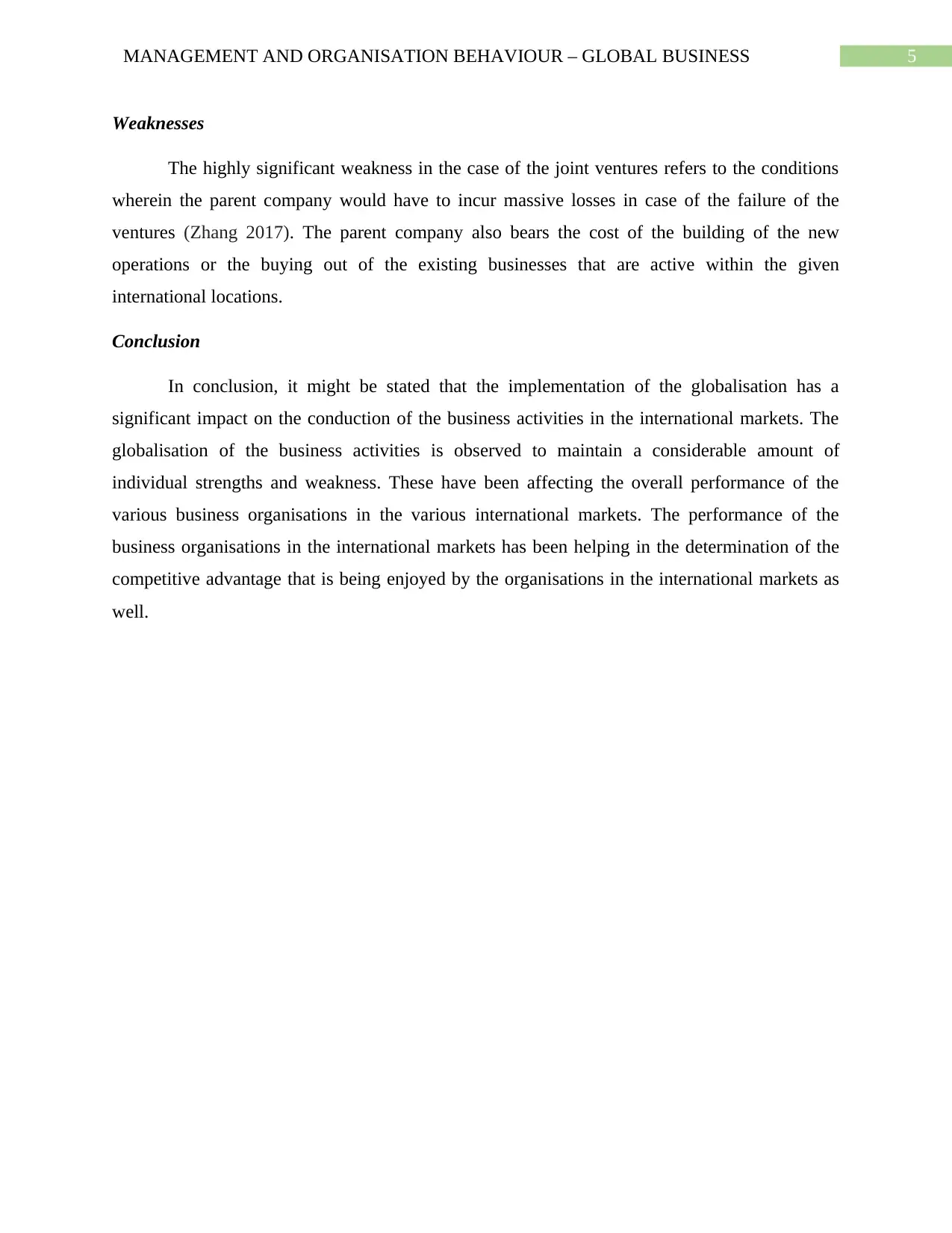
5MANAGEMENT AND ORGANISATION BEHAVIOUR – GLOBAL BUSINESS
Weaknesses
The highly significant weakness in the case of the joint ventures refers to the conditions
wherein the parent company would have to incur massive losses in case of the failure of the
ventures (Zhang 2017). The parent company also bears the cost of the building of the new
operations or the buying out of the existing businesses that are active within the given
international locations.
Conclusion
In conclusion, it might be stated that the implementation of the globalisation has a
significant impact on the conduction of the business activities in the international markets. The
globalisation of the business activities is observed to maintain a considerable amount of
individual strengths and weakness. These have been affecting the overall performance of the
various business organisations in the various international markets. The performance of the
business organisations in the international markets has been helping in the determination of the
competitive advantage that is being enjoyed by the organisations in the international markets as
well.
Weaknesses
The highly significant weakness in the case of the joint ventures refers to the conditions
wherein the parent company would have to incur massive losses in case of the failure of the
ventures (Zhang 2017). The parent company also bears the cost of the building of the new
operations or the buying out of the existing businesses that are active within the given
international locations.
Conclusion
In conclusion, it might be stated that the implementation of the globalisation has a
significant impact on the conduction of the business activities in the international markets. The
globalisation of the business activities is observed to maintain a considerable amount of
individual strengths and weakness. These have been affecting the overall performance of the
various business organisations in the various international markets. The performance of the
business organisations in the international markets has been helping in the determination of the
competitive advantage that is being enjoyed by the organisations in the international markets as
well.
⊘ This is a preview!⊘
Do you want full access?
Subscribe today to unlock all pages.

Trusted by 1+ million students worldwide

6MANAGEMENT AND ORGANISATION BEHAVIOUR – GLOBAL BUSINESS
References
Adekola, A., and Sergi, B. S. 2016. Global business management: A cross-cultural perspective.
Routledge.
Cavusgil, S.T. and Knight, G., 2015. The born global firm: An entrepreneurial and capabilities
perspective on early and rapid internationalization. Journal of International Business
Studies, 46(1), pp.3-16.
Child, J., Hsieh, L., Elbanna, S., Karmowska, J., Marinova, S., Puthusserry, P., Tsai, T., Narooz,
R. and Zhang, Y., 2017. SME international business models: The role of context and
experience. Journal of World Business, 52(5), pp.664-679.
Lee, Y.K., Kim, S.H., Seo, M.K. and Hight, S.K., 2015. Market orientation and business
performance: Evidence from franchising industry. International Journal of Hospitality
Management, 44, pp.28-37.
Lim, L.Y., 2017. The evolution of Southeast Asian business systems. Business, Government and
Labor: Essays on Economic Development in Singapore and Southeast Asia, p.243.
Peng, M.W., 2016. Global business. Cengage Learning.
Seringhaus, F.R., 2015. Export knowledge, strategy and performance. In Proceedings of the
1988 Academy of Marketing Science (AMS) Annual Conference (pp. 97-101). Springer, Cham.
Serrat, O., 2017. Learning in strategic alliances. In Knowledge Solutions (pp. 639-647). Springer,
Singapore.
Yoboue, W.K., Yi, K. and Antwi, H.K., 2017. New paradigms in international market entry: A
reflection on the present and the future. International Journal of Scientific Research in Science
and Technology, 3(3), pp.59-67.
Zhang, K.H., 2017. Foreign Direct Investment: Opportunity or Challenge for China After WTO
Membership?. In China and the Challenge of Economic Globalization (pp. 23-35). Routledge.
References
Adekola, A., and Sergi, B. S. 2016. Global business management: A cross-cultural perspective.
Routledge.
Cavusgil, S.T. and Knight, G., 2015. The born global firm: An entrepreneurial and capabilities
perspective on early and rapid internationalization. Journal of International Business
Studies, 46(1), pp.3-16.
Child, J., Hsieh, L., Elbanna, S., Karmowska, J., Marinova, S., Puthusserry, P., Tsai, T., Narooz,
R. and Zhang, Y., 2017. SME international business models: The role of context and
experience. Journal of World Business, 52(5), pp.664-679.
Lee, Y.K., Kim, S.H., Seo, M.K. and Hight, S.K., 2015. Market orientation and business
performance: Evidence from franchising industry. International Journal of Hospitality
Management, 44, pp.28-37.
Lim, L.Y., 2017. The evolution of Southeast Asian business systems. Business, Government and
Labor: Essays on Economic Development in Singapore and Southeast Asia, p.243.
Peng, M.W., 2016. Global business. Cengage Learning.
Seringhaus, F.R., 2015. Export knowledge, strategy and performance. In Proceedings of the
1988 Academy of Marketing Science (AMS) Annual Conference (pp. 97-101). Springer, Cham.
Serrat, O., 2017. Learning in strategic alliances. In Knowledge Solutions (pp. 639-647). Springer,
Singapore.
Yoboue, W.K., Yi, K. and Antwi, H.K., 2017. New paradigms in international market entry: A
reflection on the present and the future. International Journal of Scientific Research in Science
and Technology, 3(3), pp.59-67.
Zhang, K.H., 2017. Foreign Direct Investment: Opportunity or Challenge for China After WTO
Membership?. In China and the Challenge of Economic Globalization (pp. 23-35). Routledge.
1 out of 7
Related Documents
Your All-in-One AI-Powered Toolkit for Academic Success.
+13062052269
info@desklib.com
Available 24*7 on WhatsApp / Email
![[object Object]](/_next/static/media/star-bottom.7253800d.svg)
Unlock your academic potential
Copyright © 2020–2025 A2Z Services. All Rights Reserved. Developed and managed by ZUCOL.




